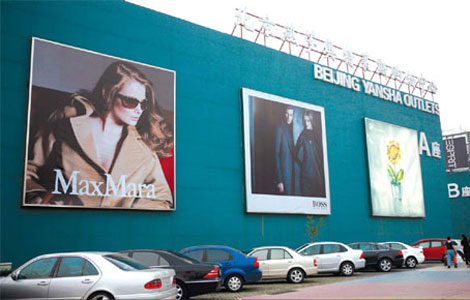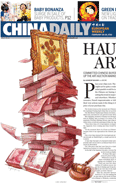Branded outlets move in
Updated: 2011-02-18 10:54
By Bao Chang (China Daily European Weekly)
 |
|
Beijing Yansha Outlets, opened in 2002, was the first outlet mall in China. The outlet market is expected to grow by 15 to 20 percent in the next five to 10 years. Provided to China Daily |
Discount retailers tap rising middle-class buyers eyeing bargains, style
The predilection of affluent Chinese consumers for luxury Western products has been well recorded, with branded shops sprouting up in all major cities.
Discount retail outlets are now trying to cash in on the burgeoning business by targeting the rapidly rising number of middle-class purchasers with an eye for a bargain as well as style.
Typical of the success story enjoyed by many top brands in China is the UK's 155-year-old Burberry Group plc, a luxury fashion house manufacturing clothing, fragrance and fashion accessories. Its distinctive tartan pattern has become one of its most widely copied trademarks.
Burberry's sales growth in China at branded stores, franchises and concessions rose a record 30 percent last year, exceeding all expectations.
This has not gone unnoticed by discount retailers. Outlets (China) Limited, backed by Beijing Capital Land and China Infrastructure Group Limited, invested 17 billion yuan (1.9 billion euros) in three malls in Beijing, Guangdong and Zhejiang last year.
"Premium brands including Hermes, Chanel, Cartier and Louis Vuitton, which seldom appear on the shelves of discount outlets, have shown an interest in entering our malls," says Lam Zhuoyan, chairman of the board of directors of Outlets (China).
Lam says top international luxury brands are attaching great importance to the outlet market in China. As a result, the company plans to open 30 stores over the next five to 10 years.
Outlet malls originated in the United States in the 1970s. They were first established in China by Yansha Youyi Shopping City in 2002. The new retailing practice grew rapidly after that, bringing together hundreds of shops under one roof, usually outside a main city and near large expressway interchanges in China, rather than in expensive city center locations.
When they first opened in the US, the country's annual per capita gross domestic product (GDP) was nearly $5,000 (3,700 euros). In 2002, China's annual per capita GDP exceeded $1,000 for the first time.
"Because of growing consumption, people's enhanced brand awareness and rising GDP, the outlet market will increase by 15 to 20 percent within the next five to 10 years," says Zhao Xueqin, a retail analyst at CITIC Securities.
According to CITIC Securities, China now has more than 200 outlet malls across the country. However, there are only 10 that meet international standards.
Zhao says Shanghai Bailian Group Limited and Beijing Yansha Youyi Shopping City, both of which have long experience in retailing and a powerful ability to attract famous brands, will probably lead the development of the market over the next few years.
CITIC Securities reported that Qingpu Outlets, backed by Shanghai Bailian Group, witnessed an increase in net profits of 50 percent from 2006 to 2009. In 2009, the net profits of the mall reached 39 million yuan, a 31.6 percent increase year-on-year.
Wan Wenying, the first general manager of Yansha Youyi who introduced the outlet business mode to China, says that in the domestic market, outlet malls selling big-name brands tended not to offer discounted prices, while those that did were not attractive enough for the high-end manufacturers.
"A lack of ability in attracting top brands is the biggest challenge facing those mall operators," Zhao says.
To ensure a plentiful variety of goods for sale and low prices, Outlets (China) is trying to purchase products from the brands' parent companies abroad instead of their sales agencies in China.
"To compete against other rivals in the market, we will provide customers with hundreds of brands priced at a 60 to 70 percent discount," the company says.
Hangzhou Xiasha Outlets, backed by Shanghai Bailian Group, also purchased goods from the countries of origin. Last year, Burberry provided more than 2,000 new collections at a discounted price when the malls opened.
"Many people can open outlets, but the low price is where there is the biggest competitiveness," Sina.com quoted Liu Xiaoguang, the director of Outlets (China), as saying.
Outlet operators are also stepping up plans to enter China's second- and third-tier cities. European retailer Retail Detail Merchandising (RDM) announced in January the company will invest 6 billion yuan to establish five outlet malls in China over the next five years.
The company's first mall will open in Tianjin this May. Ivano Poma, managing director of RDM's Asia-Pacific branch, says he expects the sales of the new mall to reach 1 billion yuan this year.
According to Linkshop.com, a Beijing retail market research website, Shanghai Bailian plans to open two new outlet malls in Wuxi, Jiangsu province and Wuhan, Hubei province, in the second half of this year.
Last year, several outlet malls were opened in Hangzhou, Changsha, Zhengzhou and Ningbo.
According to CITIC Securities, a city with 300,000 people with purchasing power can sustain an outlet mall. According to the National Development and Reform Commission, at present, there are 391 cities with populations exceeding 200,000 purchasing-empowered citizens and 122 cities with populations of more than 1 million with buying power.
"The number of outlets opened in China is far from saturation point and mature outlet malls like those in the US and Japan are still scarce," Zhao says.
In the US, there are 206 outlet malls covering more than 10,000 square meters each. In China, the number is less than 40.
"The number of outlet malls in China will surpass that of the US market soon because China's luxury goods market is growing at 10 percent every year," Zhao says.
Beijing-based Financial Times website reported that China now boasts 1,900 yuan billionaires - a third more than in 2009, and a stark jump from 24 in 2008 - and 875,000 yuan millionaires.
The Shanghai-based Hurun Report, which analyses China's wealthy, has published the findings of a survey of 401 Chinese dollar millionaires.
The average Chinese millionaire spends $380,000 a year and favors a handful of top luxury brands that Hurun ranked in the following order: Louis Vuitton, Hermes, Chanel, Cartier and Gucci. According to the survey, there is an emerging Chinese middle class with an interest in luxury goods but that possess a greater enthusiasm in shopping at outlet malls.
McKinsey and Company management consultant expects the middle class to expand from its current 29 percent of China's 190 million urban households to 75 percent of 372 million urban households in 2025.
"The upper middle classes are the ones who are ready to buy a small apartment, who own a car, who think about leisure activities more," the Chinese Financial Times website quoted Max Magni, head of the consumer products practice in China, as saying.
The lack of mature outlet malls in China is not stifling the enthusiasm of the Chinese for shopping. The emerging middle class and rich people also like to visit outlet malls abroad.
The Financial Times website reported Chinese shoppers appear to be going in their droves to Japanese outlet malls.
Those Chinese tourists may prove to be the saving grace for many operators, who, having opened a large number of outlet malls since the beginning of the 1990s, are now struggling, according to a recent article in Japan's Asahi newspaper.
For some, the growing existence of Chinese tourists is even helping malls to expand, the paper reported.
"There's no way we can ignore Chinese tourists, whose numbers are expected to further increase," premium outlet operator Chelsea Japan told Asahi.
The 200-store Gotemba Premium Outlets is one of Chinese consumers' favorite shopping centers in Japan. It is located in Shizuoka prefecture, which is close to Tokyo and to some of Japan's most famous tourist attractions such as Mount Fuji, the Izu Peninsula and Hakone, known for its beautiful mountains and hot springs.
According to Asahi, the outlet has doubled its floor space since opening in 2000 and Chinese-speaking employees have been recruited to help shoppers from China.
Asahi said there were plenty of Chinese shoppers running up to the new year.
Meanwhile, Mitsubishi Estate plans to open an outlet mall close to Tokyo's Narita Airport by 2013, specifically targeting Chinese customers, the paper reported.
Developers are not only restricting their plans to Japan. Mitsui Fudosan will open its first outlet overseas in China's Ningbo city, in Zhejiang province, this summer.
E-paper

Online shops boom in China
Low investment, quick returns offer profit-making opportunities for struggling students.
Something 'fishy' about this trick
Banking on success
Branded outlets move in
Specials

The green lantern
Environmental concerns are shedding new light on a colorful tradition

Inland interchange
Chongqing bets on its position as a hub for China's west.

Zooming in on Chinese skies
Helicopter companies ride on country's growing interest in luxury aviation.
